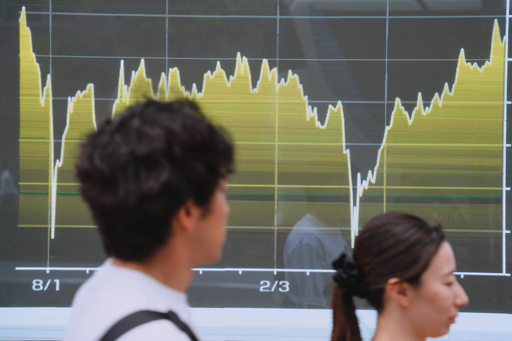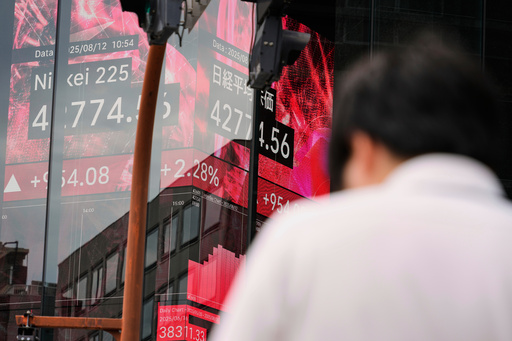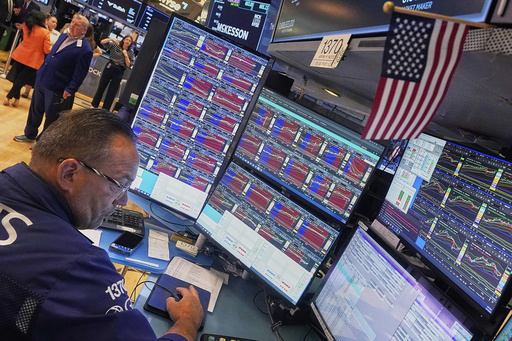


MANILA, Philippines (AP) — Asian are generally higher after most stocks on Wall Street fell following a disappointing report that said inflation was worse last month at the U.S. wholesale level than economists had expected.
U.S. futures rose while oil prices slipped.
China reported data showing its economy was feeling pressure from higher U.S. tariffs in July, while property investments fell further.
Retail sales rose 3.7% year-on-year, down from 4.8% in June, while investments in factory equipment and other fixed assets rose a meager 1.6%, compared with 2.8% growth in January-June.
Uncertainty over tariffs on exports to the United States is still looming over manufacturers after President Donald Trump extended a pause in sharp hikes in import duties for 90 days following a 90-day pause that began in May.
The Shanghai Composite index added 0.8% to 3,694.91, but Hong Kong’s Hang Seng index fell 1.2% to 25,216.45.
“Chinese economic activity slowed across the board in July, with retail sales, fixed asset investment, and value added of industry growth all reaching the lowest levels of the year. After a strong start, several months of cooling momentum suggest that the economy may need further policy support,” ING Economics said in a market commentary.
In Japan, the Nikkei 225 gained 1.7% to 43,381.10 after the government reported that the economy grew at a 1% annual pace in the April-June quarter. That was better than analysts had expected.
Elsewhere in Asia, Australia’s S&P/ASX 200 rose 0.7% to 8,938.60, Taiwan’s TAIEX gained 0.4%. India’s BSE Sensex edged 0.1% higher.
Attention later Friday will likely focus on an update on U.S. retail sales and on a meeting between U.S. President Donald Trump and Russian President Vladimir Putin.
On Thursday, seven out of every 10 stocks within the S&P 500 fell, though the index edged up by less than 0.1% to set another all-time high. The Dow Jones Industrial Average dipped 11 points, or less than 0.1%, and the Nasdaq composite fell less than 0.1% from its record set the day before.
The inflation report said that prices jumped 3.3% last month at the U.S. wholesale level from a year earlier. That was well above the 2.5% rate that economists had forecast, and it could hint at higher inflation ahead for U.S. shoppers as higher costs make their way through the system.
The data led traders to second guess their widespread consensus that the Federal Reserve will cut interest rates at its next meeting in September. Lower rates can boost investment prices and the economy by making it cheaper for U.S. households and businesses to borrow to buy houses, cars or equipment, but they also risk worsening inflation.
Higher interest rates drag on all kinds of companies by keeping the cost to borrow high. They can hurt smaller companies in particular because they often need to borrow to grow. The Russell 2000 index of smaller U.S. stocks tumbled a market-leading 1.2%.
Thursday’s disappointing data followed an encouraging update earlier in the week on prices at the consumer level. A separate report on Thursday, meanwhile, said fewer U.S. workers applied for unemployment benefits last week. That’s a good sign for workers, indicating that layoffs remain relatively low at a time when job openings have become more difficult to find.
But a solid job market could also give the Fed less reason to cut interest rates in the short term.
Big Tech stocks helped mask Wall Street’s losses. Amazon rose 2.9% to add to its gains from the prior day when it announced same-day delivery of fresh groceries in more than 1,000 cities and towns.
Because Amazon is so huge, with a market value of $2.45 trillion, the movements for its stock carry much more weight on the S&P 500 than the typical company’s.
In other dealings early Friday, U.S. benchmark crude lost 8 cents to $63.88 per barrel. Brent crude, the international standard, fell 11 cents to $66.73 per barrel.
The dollar edged lower to 147.11 Japanese yen from 147.20 yen. The euro rose to $1.1672 from $1.1654.
___
AP Business Writer Stan Choe contributed.

 Associated Press US News
Associated Press US News
 Benzinga
Benzinga NBC News
NBC News Reuters US Business
Reuters US Business The Motley Fool
The Motley Fool AlterNet
AlterNet America News
America News Raw Story
Raw Story